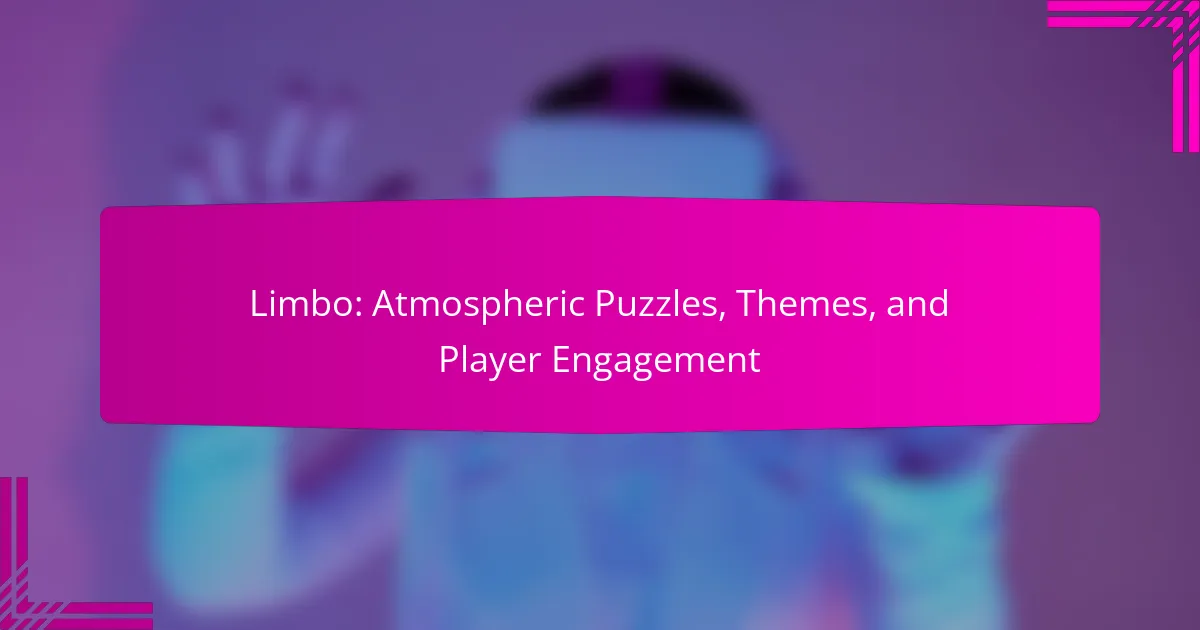Limbo captivates players with its atmospheric puzzles and emotional depth. The game’s haunting visuals and sound design create an immersive experience. Players engage with themes of isolation and existentialism while navigating intricate puzzles. The unique blend of storytelling and gameplay fosters critical thinking and exploration, enhancing overall player engagement.

What are the key atmospheric elements in Limbo?
Limbo’s key atmospheric elements include its haunting visuals, ambient sound design, and the use of light and shadow. These elements create an immersive experience that enhances puzzle-solving and emotional engagement. The unique blend of monochromatic art and eerie soundscapes establishes a sense of isolation, driving player exploration and interaction with the environment. The game’s themes of uncertainty and existentialism are reinforced through its atmospheric choices, making each encounter impactful.
How does lighting influence player experience?
Lighting significantly enhances player experience in “Limbo” by creating an immersive atmosphere. It sets the tone for puzzles and themes, influencing emotional engagement. The use of shadows and contrasts shapes player perception, guiding exploration and decision-making. This interplay between light and dark not only emphasizes the game’s unique art style but also deepens the narrative experience, making lighting a crucial element in player engagement.
What role does sound design play in immersion?
Sound design significantly enhances immersion in “Limbo” by creating an atmospheric experience that deepens player engagement. The game’s soundscape complements its visuals, reinforcing themes of isolation and tension. Unique audio cues guide players through puzzles, while ambient sounds evoke emotional responses. This synergy between sound and gameplay fosters a compelling narrative that captivates players.
Which visual styles define the game’s aesthetic?
Limbo’s aesthetic is defined by its stark monochromatic visuals, minimalist design, and atmospheric lighting. The game employs a unique art style that combines 2D silhouettes with a hauntingly immersive environment. Shadows play a crucial role in creating tension, enhancing the puzzle-solving experience. The use of fog and depth adds layers to the gameplay, making the world feel expansive yet claustrophobic.
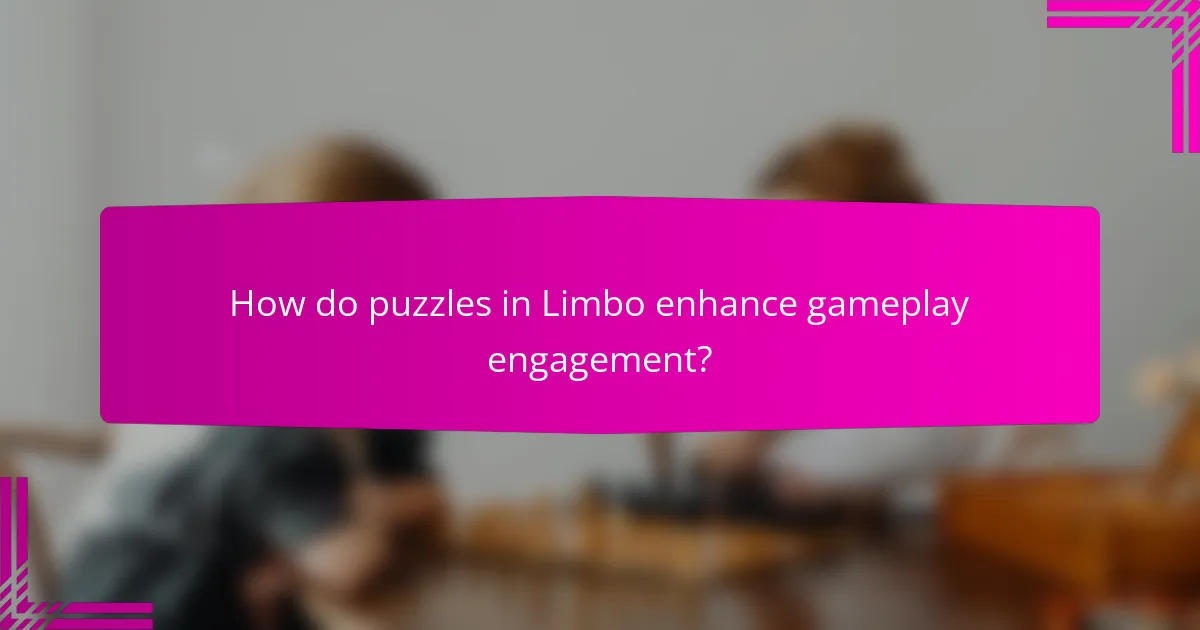
How do puzzles in Limbo enhance gameplay engagement?
Puzzles in Limbo significantly enhance gameplay engagement by challenging players’ problem-solving skills and fostering immersion. The atmospheric design of the game creates a unique environment where puzzles are seamlessly integrated into the narrative. This encourages exploration and critical thinking, keeping players invested in their progress. Additionally, the dark, minimalist art style and haunting sound design amplify the emotional stakes, making each puzzle feel consequential. As a result, players experience a deeper connection to the game world and its themes.
What types of puzzles are featured in Limbo?
Limbo features atmospheric puzzles that integrate physics, manipulation of the environment, and logic challenges. Players navigate through obstacles using unique mechanics, such as gravity shifts and light interaction. The puzzles often require creative thinking and problem-solving skills, enhancing player engagement throughout the game.
How does puzzle difficulty impact player retention?
Puzzle difficulty significantly impacts player retention by influencing engagement and frustration levels. Players are more likely to stay invested in “Limbo” when puzzles strike a balance between challenge and solvability. When puzzles are too easy, players may lose interest; conversely, overly difficult puzzles can lead to frustration. Thus, optimal puzzle difficulty enhances player satisfaction and encourages continued gameplay. A study found that 70% of players prefer challenges that require critical thinking without excessive difficulty, indicating that well-balanced puzzles are crucial for retaining players in atmospheric games like “Limbo.”
What strategies can players use to solve challenging puzzles?
Players can enhance their puzzle-solving skills in Limbo by employing strategic approaches. First, they should observe the environment closely, as visual cues often hint at solutions. Second, experimentation with different actions can lead to discovering new mechanics. Third, utilizing trial and error allows players to learn from mistakes and refine their strategies. Lastly, patience is crucial; taking time to think through challenges can reveal overlooked details and connections.
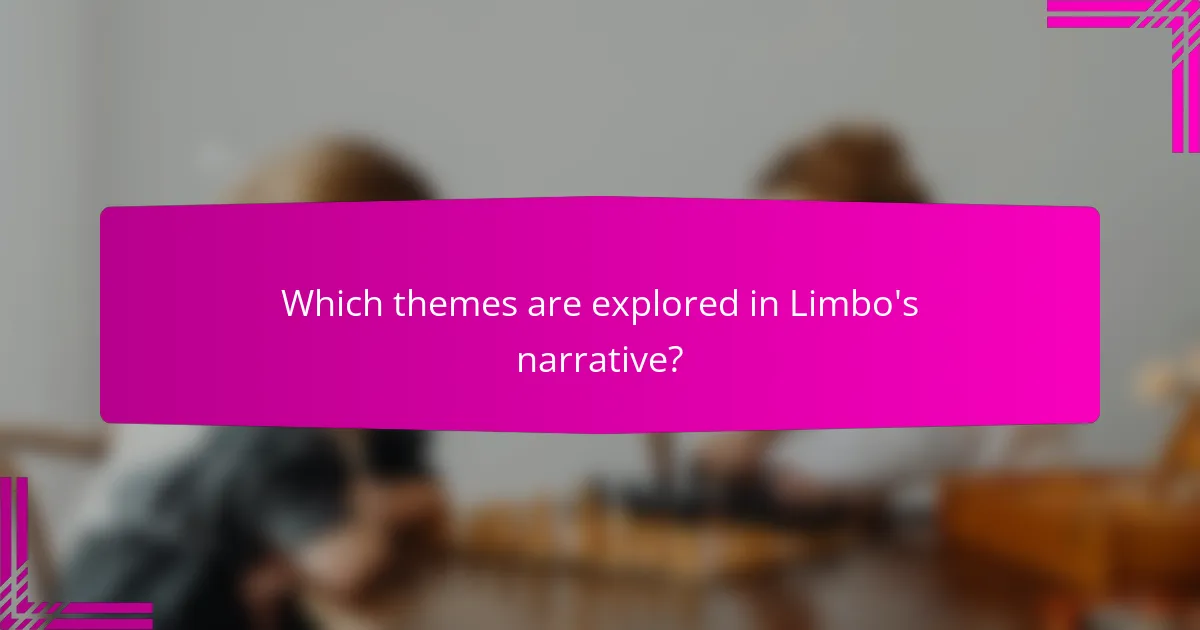
Which themes are explored in Limbo’s narrative?
Limbo explores themes of isolation, fear, and the struggle for survival. The narrative immerses players in a dark, atmospheric world that reflects the protagonist’s emotional journey. Players encounter moral dilemmas and the consequences of choices, enhancing engagement through environmental storytelling. The unique visual style and sound design further amplify these themes, creating an impactful experience.
How do themes of childhood and innocence manifest in gameplay?
Themes of childhood and innocence manifest in gameplay through atmospheric design and narrative storytelling. In “Limbo,” the use of monochromatic visuals creates a dreamlike quality that evokes nostalgia. The protagonist, a child navigating a perilous world, symbolizes vulnerability and the loss of innocence. Puzzles often require players to confront dark themes, reflecting the harsh realities of growing up. This juxtaposition between playful exploration and underlying danger enhances emotional engagement, inviting players to reflect on their own experiences of childhood.
What existential questions does the game raise?
The game “Limbo” raises profound existential questions about life, death, and the human experience. Players confront themes of isolation, morality, and the search for meaning within a dark, atmospheric environment. The puzzles serve as metaphors for overcoming obstacles in life, prompting reflection on personal struggles and choices. As a result, players engage deeply with the narrative, questioning their own existence and the nature of reality.
How do environmental storytelling techniques contribute to themes?
Environmental storytelling techniques enhance themes in “Limbo” by creating immersive atmospheres that engage players emotionally. These techniques use visual cues and environmental elements to convey narratives without dialogue. For example, the dark, foreboding landscapes reflect themes of isolation and fear, while puzzle design encourages exploration and problem-solving. This combination deepens player engagement, making the themes more impactful. Environmental storytelling effectively establishes mood, reinforces gameplay, and connects players to the underlying messages of the game.
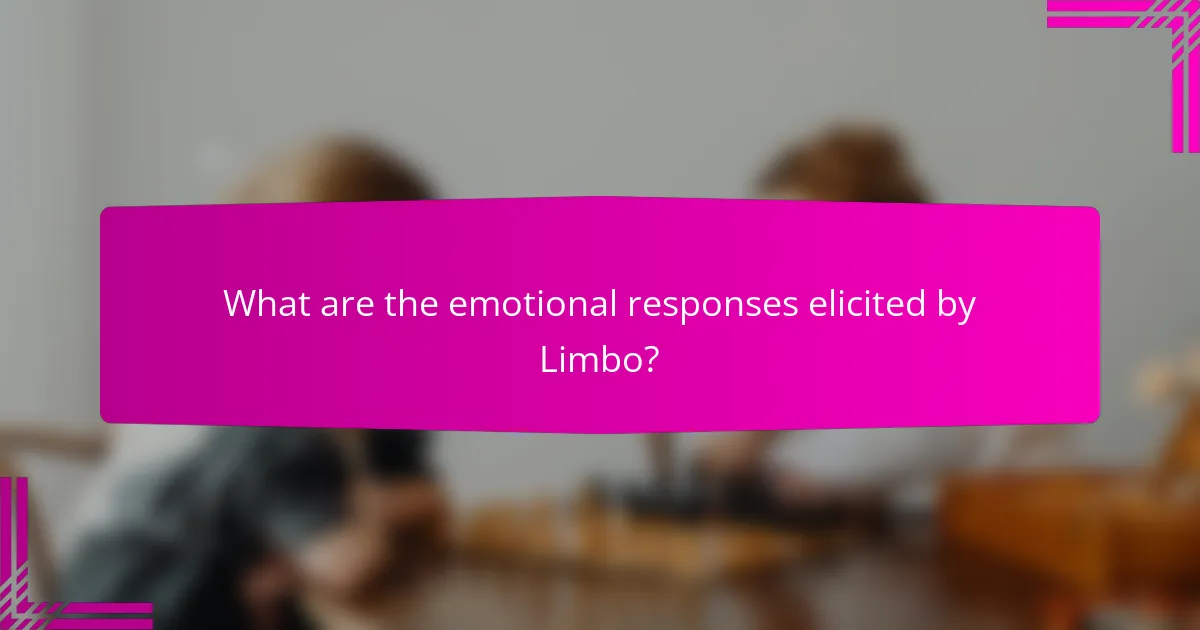
What are the emotional responses elicited by Limbo?
Limbo elicits a range of emotional responses, primarily feelings of tension, curiosity, and melancholy. The game’s atmospheric puzzles immerse players in a haunting environment that fosters a sense of unease. This emotional engagement is enhanced by its unique visual style and sound design, which create a compelling narrative experience. As players navigate challenges, they often experience frustration and satisfaction, reflecting the game’s balance of difficulty and reward.
How does player choice affect emotional engagement?
Player choice significantly enhances emotional engagement in “Limbo” by creating a sense of agency and investment. The atmospheric puzzles demand players to navigate challenges, influencing their emotional responses. Choices made during gameplay deepen immersion and connection to the narrative. As a result, players experience heightened tension and empathy for the protagonist, amplifying the overall impact of the game’s themes.
What psychological effects can the game’s atmosphere create?
The game’s atmosphere can evoke feelings of isolation, tension, and curiosity. Limbo’s dark, minimalist visuals and haunting sound design create an immersive experience that affects player emotions. The unsettling environment enhances engagement, prompting players to confront their fears and uncertainties. This psychological interplay deepens the connection to the narrative and puzzles, making the gameplay experience memorable.
Which moments in the game are most impactful for players?
The most impactful moments in “Limbo” occur during key puzzle-solving sequences and atmospheric shifts. Players experience heightened engagement when navigating the game’s dark environments, which evoke a sense of tension and discovery. Critical moments include the realization of a puzzle’s solution, the introduction of new mechanics, and encounters with unique enemies. These instances not only challenge players’ skills but also deepen their emotional connection to the game’s themes of isolation and perseverance. The combination of visual storytelling and gameplay mechanics amplifies the overall player experience.
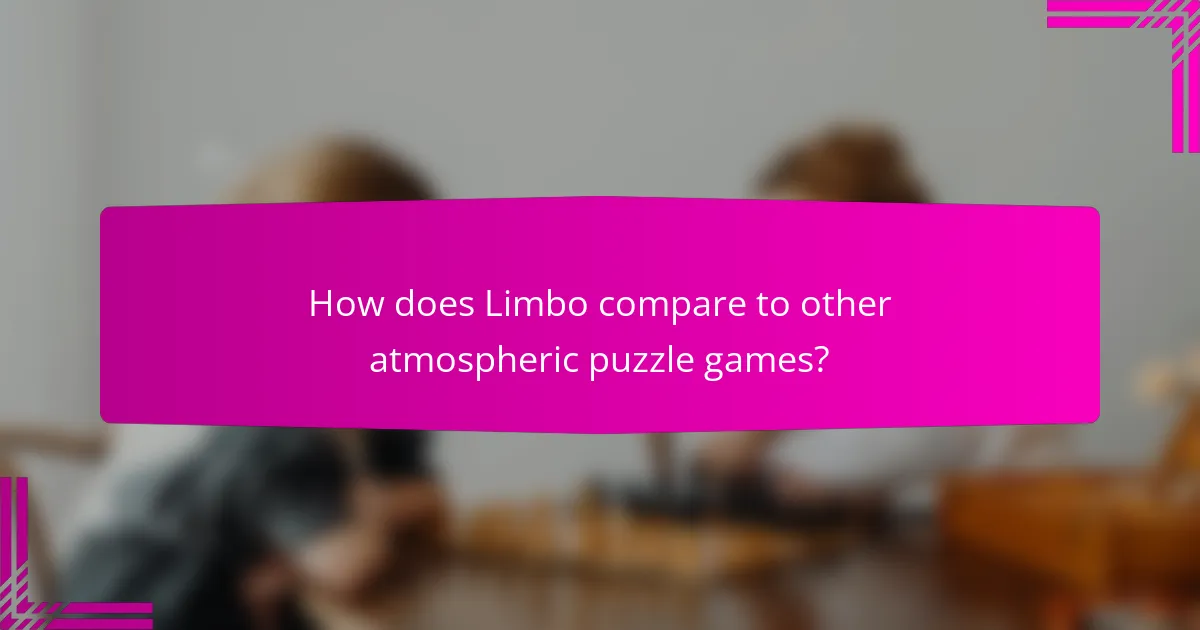
How does Limbo compare to other atmospheric puzzle games?
Limbo stands out among atmospheric puzzle games due to its unique art style and immersive storytelling. Its monochromatic visuals create a haunting atmosphere, enhancing player engagement. Unlike many competitors, Limbo emphasizes environmental storytelling, allowing players to interpret the narrative through gameplay. The puzzles are intricately designed, often requiring players to think outside the box, which adds depth and complexity. In comparison, other games may prioritize visuals or combat over puzzle mechanics, making Limbo a distinctive entry in the genre.
What unique features set Limbo apart from its peers?
Limbo stands out due to its unique blend of atmospheric storytelling, innovative puzzle mechanics, and immersive player engagement. The game’s monochromatic art style creates a hauntingly beautiful environment that enhances emotional depth. Its physics-based puzzles challenge players to think creatively, while the seamless integration of narrative and gameplay fosters a deep connection to the protagonist’s journey. Additionally, Limbo’s minimalist design and lack of dialogue compel players to interpret the story through visual cues, setting it apart from other titles in the genre.
How do player demographics influence game preference?
Player demographics significantly influence game preference by shaping engagement with themes and puzzles in “Limbo.” Younger players often favor atmospheric storytelling, while older players may appreciate complex puzzles. Cultural backgrounds also affect preferences, with some demographics drawn to darker themes and others preferring lighter narratives. Additionally, gender can influence the types of puzzles players enjoy, as studies show that women may favor cooperative gameplay, impacting their engagement with “Limbo.” Understanding these demographic factors helps developers tailor experiences to enhance player satisfaction and retention.
Which games are considered similar in style and gameplay?
Games similar to Limbo in style and gameplay include Inside, Little Nightmares, Unravel, and Hollow Knight. These titles feature atmospheric puzzles, dark themes, and engaging narratives. Inside shares a similar aesthetic and gameplay mechanics, while Little Nightmares emphasizes a haunting atmosphere. Unravel combines puzzles with emotional storytelling, and Hollow Knight offers intricate world-building and exploration.
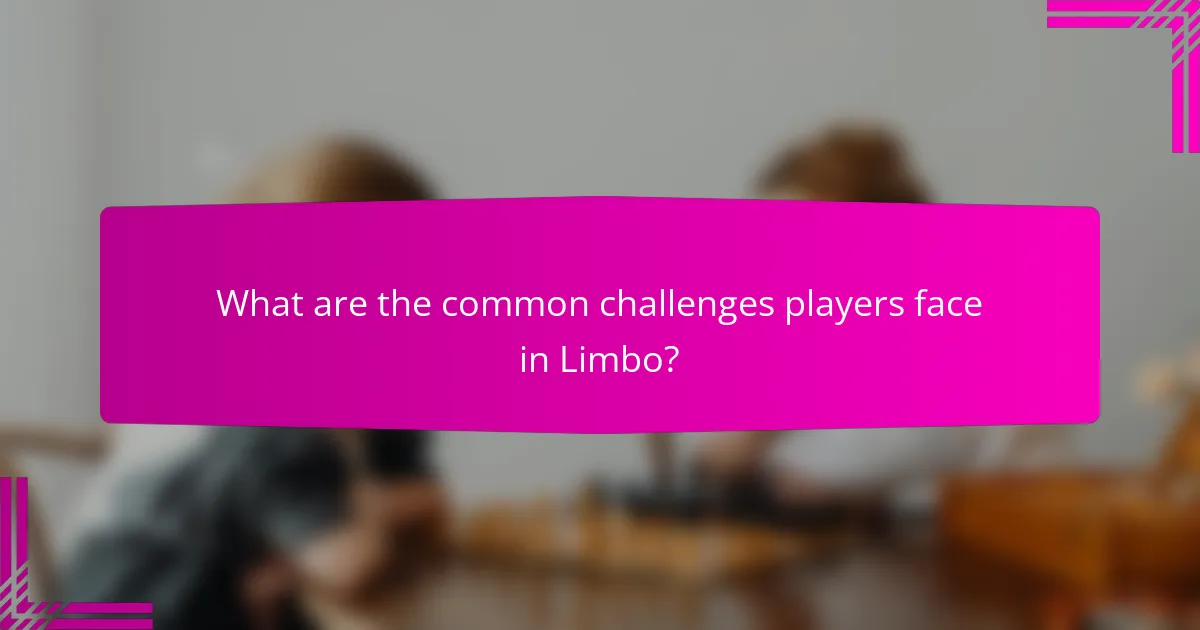
What are the common challenges players face in Limbo?
Players in Limbo commonly face challenges related to puzzle difficulty, environmental hazards, and limited visibility. These obstacles require critical thinking and precise timing to navigate effectively.
One significant challenge is the game’s atmospheric puzzles, which often demand innovative solutions. Players must experiment with various mechanics to progress. Environmental hazards, such as traps and hostile creatures, add urgency and complexity to gameplay.
Limited visibility can lead to frustration, as players may struggle to discern paths or threats. This design choice enhances the game’s eerie atmosphere but can impede player progress.
Overall, these challenges contribute to a unique gaming experience that emphasizes exploration and problem-solving.
How can players overcome frustration with difficult sections?
Players can overcome frustration with difficult sections in Limbo by employing patience, utilizing environmental clues, and practicing problem-solving skills. Focusing on the atmospheric design can enhance immersion and motivation. Players should take breaks to reset their mindset, allowing for fresh perspectives on challenging puzzles. Collaborating with others or seeking online guides can provide new strategies and insights.
What tips can enhance the overall gameplay experience?
To enhance the overall gameplay experience in “Limbo,” focus on atmosphere, puzzle-solving techniques, and player engagement strategies.
Engage deeply with the environment by paying attention to visual cues and sound design, as they are integral to solving puzzles. Experiment with different approaches to puzzles, as some may have multiple solutions.
Take breaks to avoid frustration and return with a fresh perspective. Immerse yourself in the themes of the game, which can enrich your understanding and enjoyment.
Consider sharing experiences with the community, as discussions can provide new insights and strategies.
What are the most frequently reported issues by players?
Players frequently report issues related to gameplay mechanics, puzzle difficulty, and technical glitches in Limbo. Common concerns include frustrating controls, unclear objectives, and occasional bugs that disrupt the immersive experience. These factors can hinder player engagement and enjoyment, impacting overall satisfaction with the game.
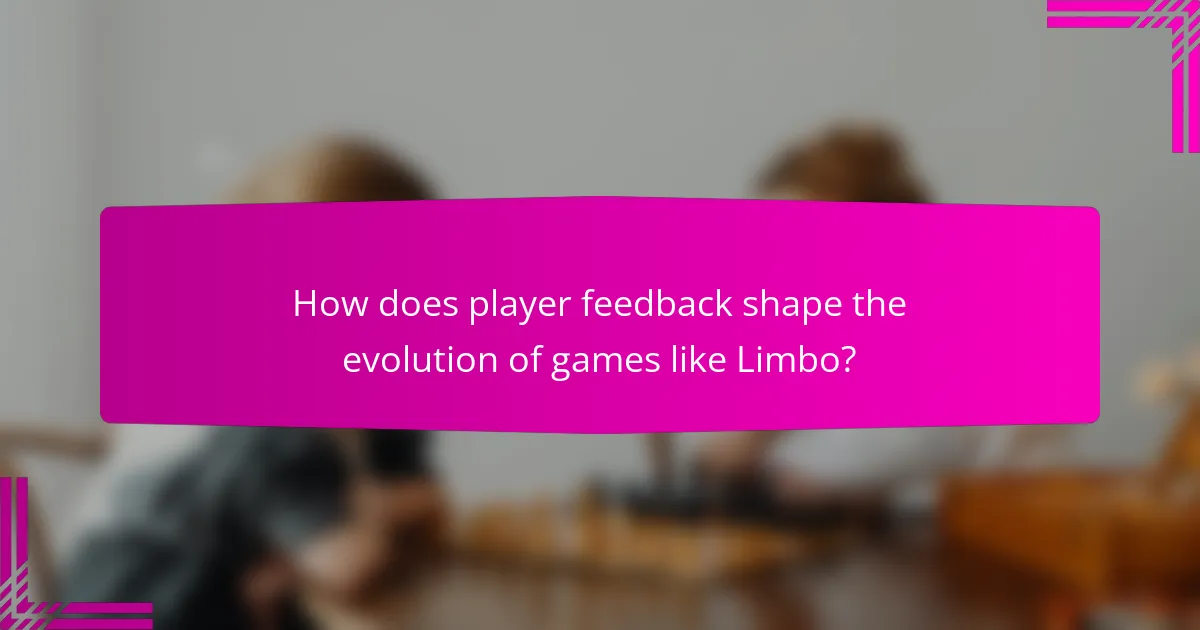
How does player feedback shape the evolution of games like Limbo?
Player feedback significantly influences the evolution of games like Limbo by shaping design choices and enhancing player engagement. Developers analyze player responses to puzzles and narrative elements, allowing for adjustments that improve gameplay experiences. For instance, feedback on puzzle difficulty can lead to refinements that balance challenge and satisfaction. Additionally, player suggestions may inspire new content or themes, enriching the overall atmosphere. This iterative process fosters a community-driven development approach, ensuring that the game resonates with its audience while maintaining its unique attributes.
What role does community engagement play in game development?
Community engagement enhances game development by fostering collaboration, feedback, and shared creativity. In “Limbo,” player involvement shapes puzzle design and thematic depth, creating a more immersive experience. Engaging communities allows developers to understand player preferences and refine gameplay elements. This iterative process leads to a game that resonates more profoundly with its audience, ultimately improving satisfaction and retention.
How do developers respond to player critiques?
Developers respond to player critiques by actively engaging with feedback and making adjustments. They often analyze player comments to identify common themes, addressing concerns through updates or patches. This iterative process enhances player experience and fosters a sense of community. For example, in “Limbo,” developers incorporated player feedback to refine atmospheric puzzles, ensuring they align with player expectations and emotional engagement. This responsiveness not only improves gameplay but also builds trust and loyalty among players.
What trends in player feedback are emerging in 2025?
In 2025, player feedback trends for “Limbo: Atmospheric Puzzles, Themes, and Player Engagement” show a growing demand for immersive storytelling and enhanced interactivity. Players increasingly appreciate atmospheric depth and emotional engagement in puzzle-solving experiences. They seek more complex themes that challenge their perspectives and foster community discussions. Unique player-generated content is gaining traction, as users desire personalized gameplay experiences. Feedback indicates a preference for adaptive difficulty levels, allowing for tailored challenges that cater to varying skill sets.
What best practices can enhance player engagement in atmospheric games?
To enhance player engagement in atmospheric games like Limbo, developers should focus on immersive storytelling, environmental interaction, and emotional resonance. These practices create a deeper connection between players and the game world.
Incorporating rich narratives that unfold through gameplay encourages exploration. Players are more likely to engage when they feel invested in the story and its characters. Environmental interaction is key; puzzles that require players to manipulate their surroundings enhance immersion.
Additionally, using sound design and visual aesthetics effectively can evoke strong emotions. Players often remember experiences that resonate emotionally, leading to greater engagement.
Lastly, providing subtle hints and feedback during gameplay can guide players without breaking immersion, ensuring they remain challenged yet supported.
